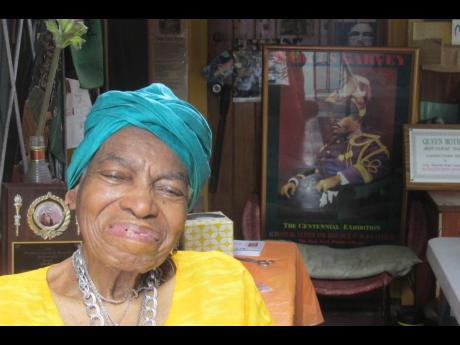The black that she was - Part II
Paul H. Williams/Gleaner Writer
Muriel Allman was perhaps not singular in her black pride and the extraordinary way in which she embraced her blackness, but she might have well been. The impact that she has had on so many black people transcended national borders. It was like she took a brush of black pride and daubed it all over the place.
Jamaica was one of the places which felt her influence. At age 17, she married Clarence Thomas, a Jamaican man from Porus, Manchester. He was 27. They met in the Universal Negro Improvement Association through her parents when she was 15. They eventually produced two children.
At the time of the courtship Allman, the agnostic, did not know her husband was converted from Catholicism to Islam. When she discovered that Thomas wanted the family to change its name, Allman refused to be a part of the transformation, but relented after some thugs went to kill their son, Teddy Thomas. It was a case of mistaken identity. It was to be another Teddy Thomas, and his life was spared.
The name change happened. Thomas became Abdul Samad, Muriel chose Mariamne. Their son was renamed Sayeed and daughter Sayeeda. Mariamne confessed to The Gleaner in a 2017 interview that she went along with it for peace’s sake. She did not subscribe to any of it.
In agreement or not, she got a new name and perhaps a new religion, but nothing else changed. She was still unapologetically black, a black woman who sent her daughter to experience Jamaica’s Independence in 1962. But, Sayeeda Samad, who sported a ‘Makeba’ hairstyle, such as that worn by South Africa’s international singing sensation, Miriam Makeba, got the shock, maybe, of her life. Black Jamaicans laughed at her.
Her mother, too, was jolted out of her wits when she visited the land of her husband’s birth in 1965. Black Jamaicans, she said, did not want to be fully black. They wanted to be half this and half that. Her own mother-in-law was not pleased with the woman her son married. She was too dark, with a rust-coloured Afro hairstyle, and wore African clothes all the time. Jamaica turned her off, and she was not going to change for Jamaica, so she left.
Despite the initial negative experience in Jamaica, Samad returned in 1975 when her husband retired at age 63. From day one she set out to teach young people to be proud of their blackness. Her home became a place where people go on Saturdays and Sundays to learn about Africa and Marcus Garvey. It was a ‘school’ and a ‘museum’.
She introduced Kwanza (‘black people Christmas’) to Jamaica, participated in numerous Afrocentric events, and taught many Jamaican women to sew African clothes. In 1999, during Heritage Week, she as enstooled as Queen Mother, as she was in Ghana in the 1970s. Her husband predeceased her in the late 1980s.
Much can be said about Queeen Mother Mariamne Samad, but when The Gleaner asked her to summarise her own life, without hesitation she said, “I have had a wonderful black life, you know. You hear so many of our women talking about being raped, and touched and lavished, cheated on, lied to, I never had that, you know. I thank God for spoiling me.”
She declared further, “At 94, I got nothing to regret being black from babyhood … My story as a black woman and the wonderful things about being black is that there are so many shades of us that I have a lot of sisters, and all my life I have been treated pretty well by my sisters.”
Fast forward to Thursday, September 5, the day Queen Mother Mariamne Samad quietly faded to black into the realms of her black ancestors. She was 97. On Sunday, September 8, at her farewell procession inside the mosque at Camp Road in Kingston, as it rained in torrents she lay in a deep-brown casket. It might as well be black, without any apology.

